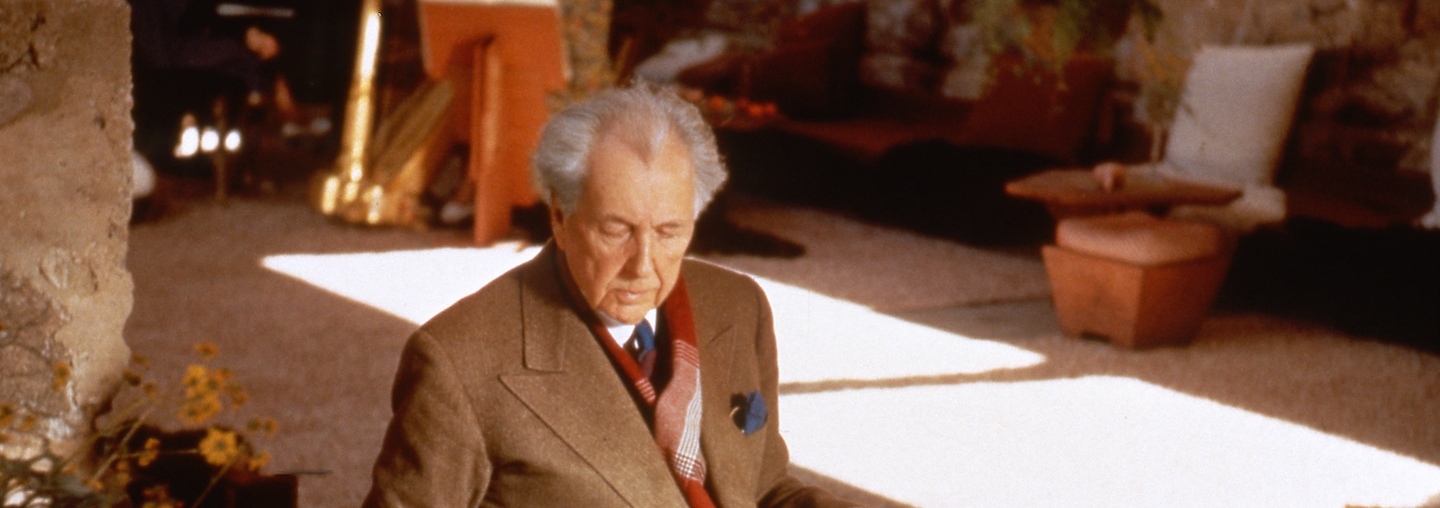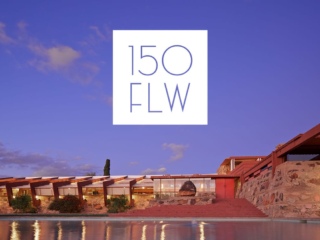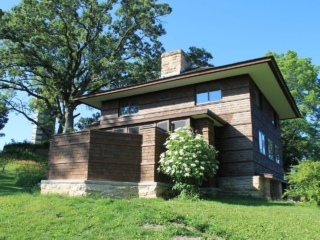
Celebrating Frank Lloyd Wright with Music
Effi Casey | Aug 3, 2017
Two concerts at Taliesin’s historic Hillside Theater celebrate the 150th anniversary of Frank Lloyd Wright’s birth. Taliesin Music Director, Effi Casey, and Jason Silverman reflect.
“… Never miss the idea that architecture and music belong together. They are practically one.” – Frank Lloyd Wright
I feel a great sense of gratitude for the many gifts Frank Lloyd Wright left us and, with this concert, hope to contribute to the occasion of the 150th anniversary of his birth with a gift of music, music that expresses, from generation to generation, Creative Spirit, Nature, Freedom, Peace. In search for programmatically reaching beyond “what Frank Lloyd Wright liked,” I spoke with my good friend Bill Lutes, pianist and teacher in Madison, Wisconsin, and we quickly came to the conclusion that to honor Wright would mean a program which celebrates American Creativity. Bill further inspired me to consider celebrating American Living Creativity by commissioning a young composer, Scott Gendel, to write a piece specifically in honor of Wright’s 150th anniversary. The initial hesitation, as I had no experience in commissioning music from anyone before, was quickly turned into excitement when Scott Gendel responded positively to my request. The “orchestration” was clear from the start in my mind: a composition for choir, string quartet and piano which Gendel readily accepted. What text though? Frank Lloyd Wright? Walt Whitman?

Effi Casey (Photo by Kate Chesley)
Again, a knowledgeable friend and colleague, architectural historian and educator, Sidney Robinson, came to my aide. In describing my ideas for the commission and search for an appropriate text, Sidney recited the first lines of the T.H. Wijdeveld foreword to the 1925 publication of “The Life-Work of Architect Frank Lloyd Wright,” entitled “Some Flowers for Frank Lloyd Wright”:
“Out of the distance comes that which is near, out of rest comes that which is in motion. Trees rise up from the field, mountains from the valley. All is a picture of growth and unity. Eternally changing forms manifest the same wonderful secret of Nature…”
Perfect. These words resonated well with Scott Gendel, especially after experiencing Taliesin and walking the grounds.
The Wijdeveld words are now underlying the Gendel’s composition and how in tune do they sound with Wright saying that “There is nothing higher, that I can see, than the deep and full understanding and appreciation of beauty around you – the beauty one might say, who made the body of God the Great idea.”
While Wright claimed architecture as the “mother art,” his experience in music was early, visceral, and eternal. Of his childhood he wrote in “An Autobiography”: “…father taught him [the boy] to play [the piano]. His knuckles were wrapped by the lead pencil in the impatient hand that would sometimes force his hand into position at practice time on the Steinway Square in the sitting room. But he felt proud of his father too. Everybody listened and seemed happy when father talked on Sundays when he preached, the small son dressed in his home-made Sunday best, looked up at him, absorbed in something of his own making that would have surprised the father and the mother more than a little if they could have known.”
In his later years, Wright himself preached musical integration in his own Sunday talks to the Fellowship:
“Of all the fine arts, [Wright exclaimed in a Sunday morning talk to his apprentices] music it was that I could not live without – as taught by my father. [I] found in it [a] sympathetic parallel to architecture. Beethoven and Bach were princely architects in my spiritual realm…”

Living Room at Taliesin.
But more than words, it was in practice where he conveyed music to those in his sphere, from a piano designed into a client’s home (who may or may not have been able to play it!) to his own score of concert grand pianos at the two Taliesins (he claimed “the piano plays me!”). In a gesture of delight and exuberance, as it is told by those who experienced it, Wright had a gramophone player installed at the top of his Romeo and Juliet tower at Taliesin to have Bach’s Mass in B Minor resound over the verdant hills and valleys.
Architecture is indeed a musical parallel of composition, rhythm, pattern, texture, and color. As Beethoven’s Fifth Symphony is an “edifice of sound” (Wright) built upon the famous first eight notes, so Wright’s overture of verse expresses a singular IDEA, played in stone, wood, and concrete, from superstructure to matching porcelain cup.
At the same time as there is grandness about Wright’s work, there is also a quietness about him, when he notices the modest wild flower at the wayside or one experiences the repose of Taliesin, as it quietly extends from the hill, greeting the day, touched by the morning sun.
Wright gave us the tools to “stay the course” in pursuit of “that great living creative spirit which from generation to generation, from age to age, proceeds, persists, creates, according to the nature of man and his circumstances as they both change.”
In a collaboration between Taliesin Preservation and Rural Musicians Forum, the “Beautiful Music in a Beautiful Space” summer concert series concludes with two choral concerts at Taliesin’s Hillside Theater (located at 6604 State Highway 23, Spring Green , WI) on Sunday, August 6 at 2:30pm and Monday, August 7, 2017 at 7:30pm.
I consider myself privileged to draw on the amazing talent in the greater Spring Green community and to inspire singers and instrumentalists to explore together extraordinary works of music as an enrichment of life.

The program includes: Fanfare for the Common Man by Aron Copland, Past Life Melodies by Sarah Hopkins, Ev’ry Time I Feel de Spirit, Spiritual, Hymn to Nature (from Shining Brow) by Daron Hagen, Song of Peace by Jean Sibelius, World Premiere ‘That Which is Near’ by Scott Gendel, in honor of FLW’s 150th anniversary, Sanctus and Dona Nobis Pacem (from Mass in B Minor) by Joh. S. Bach and spoken words.



